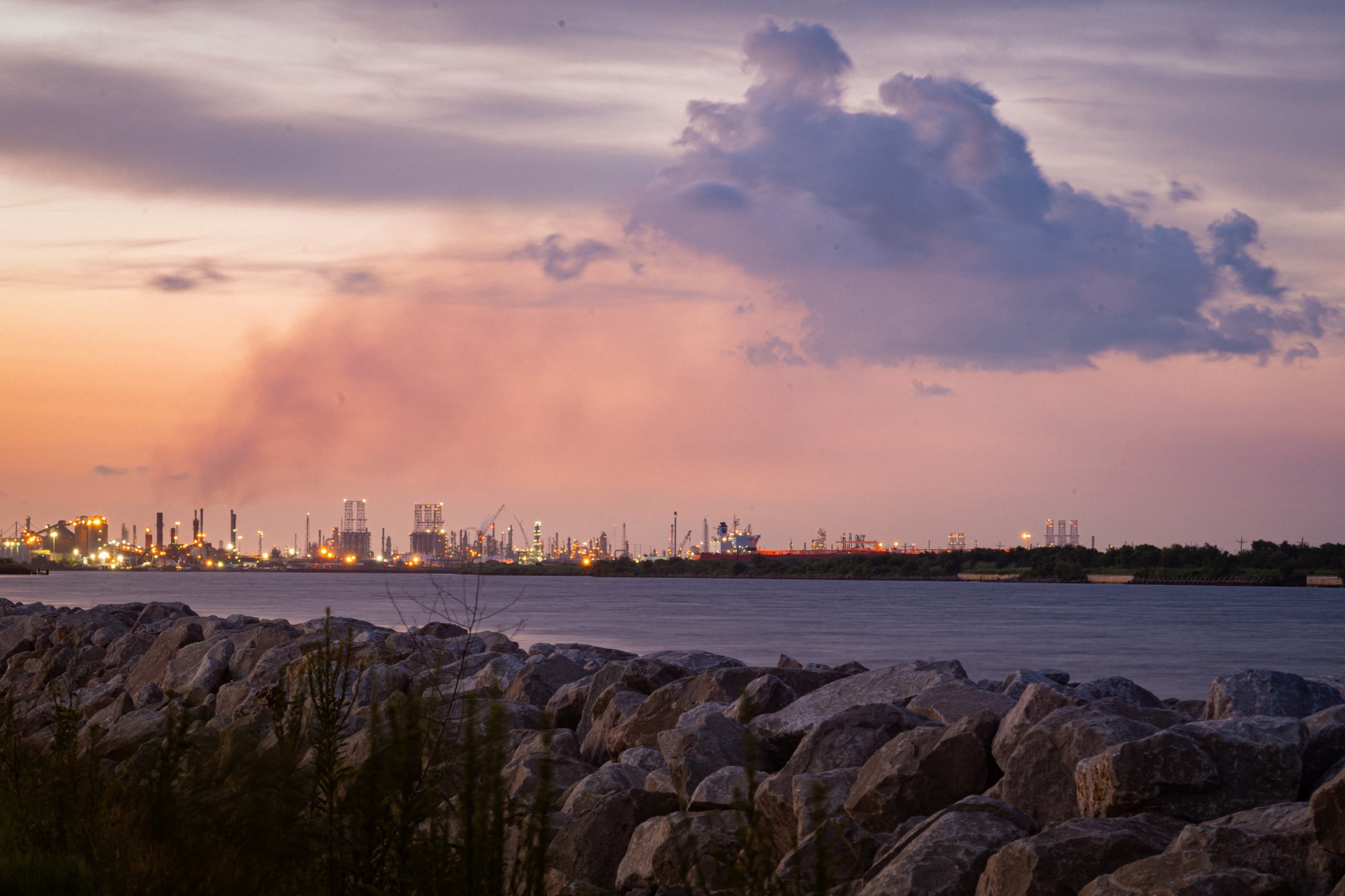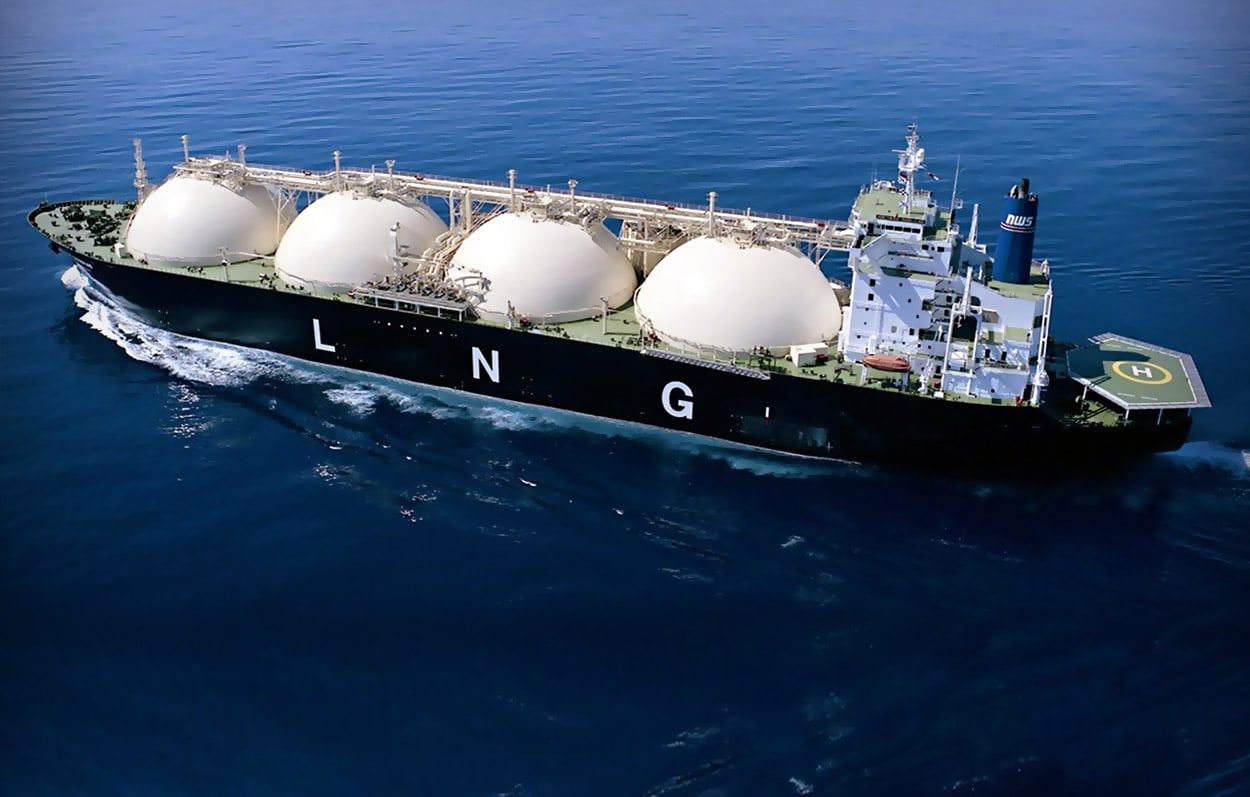Photographs by Ivan Armando Flores
The viewing deck at Port Arthur’s City Hall offers visitors to the industrial city a view of the small downtown and the glimmering waterway. The channel is lined with massive tankers and refineries. John Beard, a former city councilman, can name each and every facility that’s visible on the horizon. Just like a city booster in another town might point out skyscrapers and their architectural features, Beard can tell you what each facility produces and what pollutants are carried in the plumes of gray-brown smoke from their flares.
Beard has lived in Port Arthur for most of his life and spent decades working at the local Exxon plant. Now retired, he’s found himself on the other side, fighting off the industrial expansion that fueled Port Arthur’s growth for more than a century.
Port Arthur bills itself as the Energy City. The tagline is plastered all over city hall. The oldest refineries in Port Arthur date back to 1901: The same year that Spindletop, the state’s first major oil gusher, erupted in nearby Beaumont, Gulf Oil built the town’s first refinery. By 1914, Port Arthur was one of the nation’s largest oil refining ports.
“My parents came here in the late ’20s and early ’30s,” Beard says. “We were right next to the old Texaco plant. I have family pictures of me as a young boy, and our house was so close that you could lean out the window and touch [Texaco’s] fence.” His father worked at one of the city’s refineries, and the steady salary allowed him to buy a home. “That was Port Arthur’s economy: You worked for Gulf or Texaco or the City of Port Arthur or the school district.”

The industrial landscape Beard knows so well has blanketed Port Arthur in harmful air pollution, leaving the city with rates of cancer higher than the state average, particularly among Black residents, who are more likely than white residents to live closer to the industrial facilities.
And as oil and gas companies have automated their operations, the jobs are increasingly scarce. For years, both as an industry employee and a city official, Beard has heard companies like Exxon and Motiva promise jobs and prosperity for residents of the predominantly Black community and then hire people from out of town or out of state for the highest-salaried jobs. Beard knows community members who have degrees in chemical engineering and haven’t been able to get a job at one of the plants.
In the next few years, the city is poised to become one of the nation’s largest liquified natural gas (LNG) export hubs, piping in natural gas from the Permian Basin in West Texas, chilling it to subzero temperatures, and loading the gas, now in liquid state, onto tankers headed for Europe and Asia, where it will be burned in power plants. Exxon Mobil’s Golden Pass facility is under construction, and Sempra Energy is planning to move forward with its facility just up the river. When they’re both up and running, the plants will have a combined export capacity of nearly 30 million tons of LNG per year.
Port Arthur isn’t alone. All along the nearly 400-mile stretch of Texas’ Gulf Coast, nearly a dozen oil and gas export terminals are slated to come online within the next decade. The Gulf Coast as a whole has long been a major energy hub, with nearly half of the nation’s existing oil and gas refining capacity already here. For decades, the facilities built here were import-oriented: The United States was consuming far more energy than the nation could produce. That began to change in 2008, when a revolution in fracking freed up millions of barrels of oil and gas trapped in shale formations in Texas, Pennsylvania, and North Dakota. Then, in 2015, Congress repealed a decades-old ban on crude oil exports, opening the floodgates of American oil and gas to the rest of the world.
In towns like Port Arthur, coastal residents are fighting against the new wave of oil and gas export plants: challenging permits, staging protests at home or joining forces with activists abroad, and calling for an outright ban on all fossil fuel exports. Farther down the coast, communities are rallying to stop industry from entering their area altogether. In Brownsville, local opposition to two LNG export plants started when the proposals were first submitted for review seven years ago.
By 2024, Texas’ LNG production capacity is on track to quadruple, from 30 million tons a year to nearly 120 million tons per year. Almost all of the United States’ oil exports already leave from the Gulf Coast, where pipelines and refineries crisscross the landscape. In 2020, the U.S. exported an average of 3 million barrels of oil a day. When a wave of new terminals is completed, sometime in the next decade, Texas alone would have the capacity to export more than 7 million barrels a day. The export facilities and expansions proposed in Texas could propel the United States to becoming one of the largest oil and gas exporters in the world, surpassing nations like fossil fuel–rich Qatar.

But the terminals will irrevocably change the coast’s ecology. Acres of sensitive wetlands, marshes, and prairies that provide safe shelter for millions of migratory birds and sea turtles will be disrupted or destroyed. Naturally shallow bays and inlets will be dredged to make room for some of the largest shipping containers in the world, burying oyster reefs and fisheries. The communities who live closest to the plants will breathe dirtier air as the plants emit thousands of pounds of toxic chemicals like benzene, volatile organic compounds, and carbon monoxide. When the exported oil or gas is burned for power halfway around the world, it will release vast amounts of greenhouse gases, which fuel climate change. The already vulnerable Texas coast will be even more prone to deadly heat waves, strong storms, and long droughts.
“Communities on the Gulf Coast are already hit hard by climate disasters,” says Ethan Buckner, an organizer with the environmental watchdog group Earthworks. “They are impacted by the acute increase of emissions and pollution, and now they are being asked to take on the burden of new pipelines, storage terminals, processing plants, and dredging projects—it’s sacrificing the communities and the climate.”
President Joe Biden has promised to slash the nation’s emissions as he rejoined the Paris Climate Accord, an international agreement to limit the impacts of global warming. But none of the commitments Biden has made so far are binding, and his administration hasn’t announced plans to rescind permits for any of the proposed export facilities.
While it’s unlikely that every proposed plant will get built—the oil and gas market is notoriously volatile—most companies are moving forward with the permitting process in the hopes of shoring up enough interest and investments for the projects. According to a 2020 study by the Environmental Integrity Project, if the 20 LNG plants currently operating, under construction, or under consideration nationwide—including the six in Texas—reach full capacity, they would increase global greenhouse gas emissions by nearly 100 million tons per year, while crude oil export terminals could add an additional 1.6 millions tons of carbon emissions annually. But those numbers, which are just over 1 percent of the nation’s yearly emissions, account for only carbon emissions from processing the fossil fuels and loading them onto tankers. The true cost, including the methane released in the Permian Basin and the fuel actually being burned at a power plant, makes these projects much more carbon-intensive.
In Port Arthur, Sempra Energy’s CEO has touted the company’s LNG export facility as part of a “global shift to sustainable energy systems,” since LNG typically displaces coal, another dirty fossil fuel, as a power source. But John Beard isn’t buying that argument. “Whatever [pollution] it is, no matter how minute, the effects are cumulative,” he says. “Just a drop more is more. It doesn’t matter.”
In Portland, locals have different nicknames for the towering, roaring flare that never goes out at Corpus Christi LNG. Some call it the eternal flame; others call it the tiki torch. Errol Summerlin sometimes calls it the Eye of Sauron, as it flickers over the town’s country club golf course. Stucco houses with Spanish-tile roofs, some of the most expensive homes in town, open out to breathtaking views of the bay’s sparkling blue waters on one side and an uninterrupted view of the LNG plant on the other. The irony isn’t lost on Summerlin, a retired legal aid lawyer. Much of his career involved representing clients in Corpus Christi who were facing pollution and displacement. Most of the time, those neighborhoods were lower-income communities of color.
Now, he says, the industry doesn’t give a damn where it pollutes.
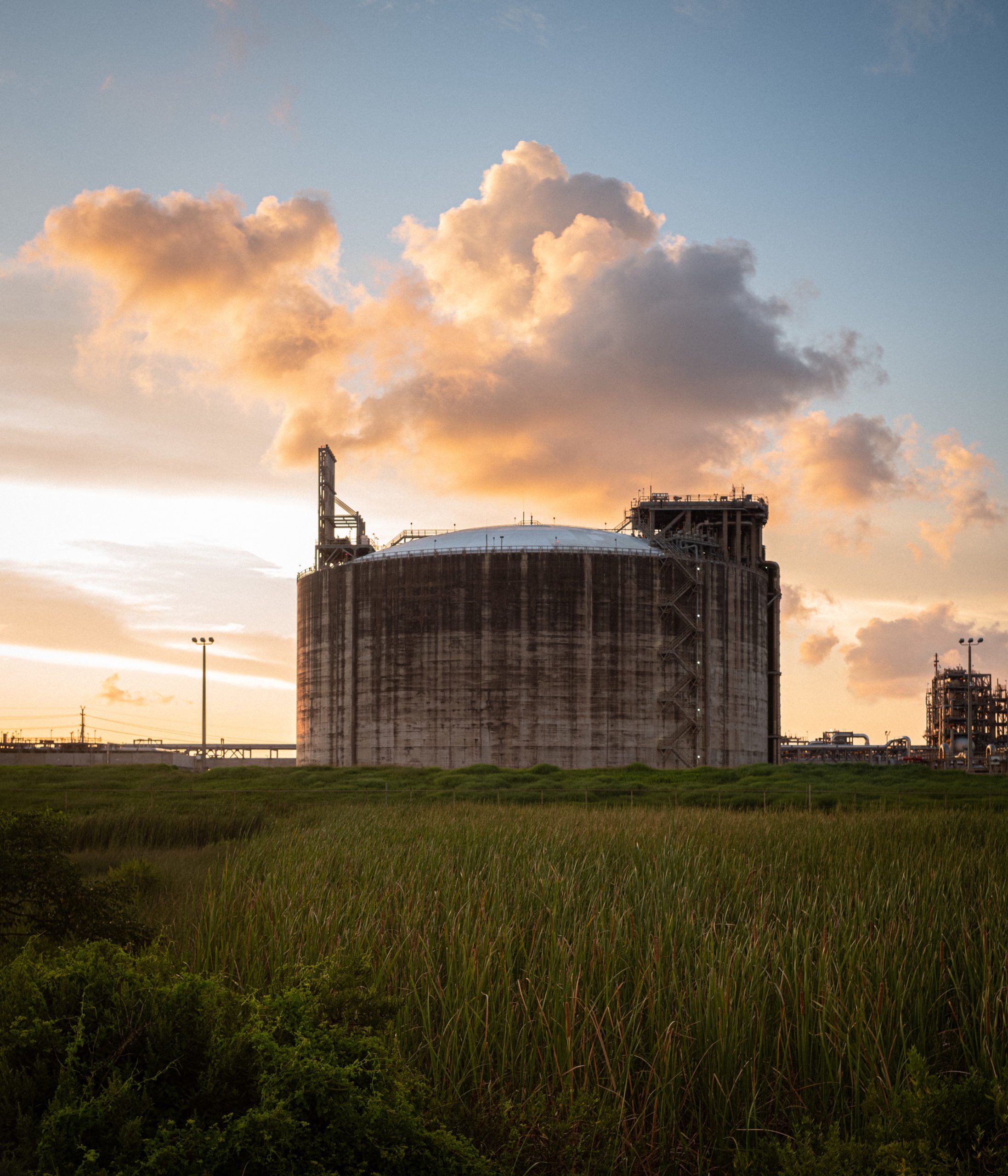
When the flare at Corpus Christi LNG is lit, it releases—according to the company’s incident reports with the Texas Commission on Environmental Quality (TCEQ)—hundreds of pounds of pollutants: volatile organic compounds, nitrogen oxides, carbon monoxide, and greenhouse gases like carbon dioxide or methane. The same is true at Freeport LNG, which has racked up more than 100 emissions violations since 2019. TCEQ has fined the company once: When an accident at the plant released more than 20,000 pounds of carbon monoxide into the air over five hours, the company paid a $9,900 fine. The agency has never issued a fine against Corpus Christi LNG.
“The fine is kind of a joke,” says Melanie Oldham, a local activist who has been fighting for cleaner air in Freeport for more than a decade. The town, an industrial hub about an hour south of Houston, has long suffered from air quality that fails to meet federal clean air standards. “We have to suffer the pollution, and we don’t get any benefits of any kind,” she says. A quarter of Freeport’s residents live in poverty, and the region has elevated rates of cancers.
Cheniere was one of the first companies to export LNG out of Texas in 2018, and now it’s planning to expand its Corpus Christi facility with up to seven new processing units. That will increase its processing capacity from 15 million tons to 25 million tons per year, and the company has applied for a permit to pump out more pollution to keep pace with that growth. Freeport LNG, meanwhile, plans to expand its facility from its current capacity of 15 million tons to 20 million tons annually. In a statement, a Cheniere spokesperson said that the company “produce[s] energy that helps countries around the world reduce air pollution and toxins.” Freeport LNG did not respond to requests for comment.
In June, Corpus Christi residents filed a contested case hearing with TCEQ—an administrative procedure that allows private citizens to challenge state permits that might have an impact on them directly. In the complaint, residents say that when the flare is lit, their respiratory illnesses act up, and they’re worried about their children’s health.
“One of the issues that we have with the facility is that they are [already] reporting emission events where they are exceeding some of their permitted levels from the flares,” says Colin Cox, a lawyer with the Environmental Integrity Project representing Portland residents. The complaint also alleges Corpus Christi LNG has failed to use the most advanced available technologies to reduce air pollution. “We see time and time again, a company is granted a permit based on certain representations, and once they build the facility, it turns out they can’t quite meet the limits.”
BECOME A MEMBER OF THE TEXAS OBSERVER
You can chip in for as little as $3 a month.
Some locals have taken their fight beyond Texas: In August, a handful of activists and environmentalists from along the Texas coast went to the German town of Brunsbüttel, where they joined anti-LNG activists who say that they don’t want fracked natural gas from the U.S., or its methane emissions. The import terminal would be Germany’s first, as most of the country’s natural gas supply comes from Russia.
“Places like Germany have banned fracking,” says Elida Castillo, the program director of Chispa Texas and one of the activists who traveled to Germany. “So they don’t allow it on their own land, but they don’t mind exploiting low-income communities in the United States.”
Massive white wind turbines dot the flat expanses of ranchland that surround Corpus Christi, their wide blades spinning slowly with the coastal breeze. In Germany, Castillo saw acres and acres of turbines spread between the small countryside towns, offering a vision of what the future could look like, at home and abroad.
Mauricio Blanco has been a shrimper in Matagorda Bay, halfway between Houston and Corpus Christi, for more than 30 years. He got his start with a couple of shrimpers who adopted him into their business, and their family, as a teenager. In recent years, it’s been harder and harder for independent fishermen like Blanco to make a living off the water. They had always been able to sell their catch at one of the many docks in Port O’Connor, Port Lavaca, or Seadrift. But nowadays, the families who used to own the docks have started selling them off or renting dock space to industrial dredgers instead of fishermen. There are fewer places to sell shrimp, oysters, and bait to customers.
Blanco’s own children, mostly grown now, love being on the water. But he doesn’t plan on letting any of them inherit his business. In fact, he’s already got plans to sell off his boats, one at a time, and quit the industry altogether. “We make money,” Blanco says. “But sometimes I don’t know where it goes.”
-
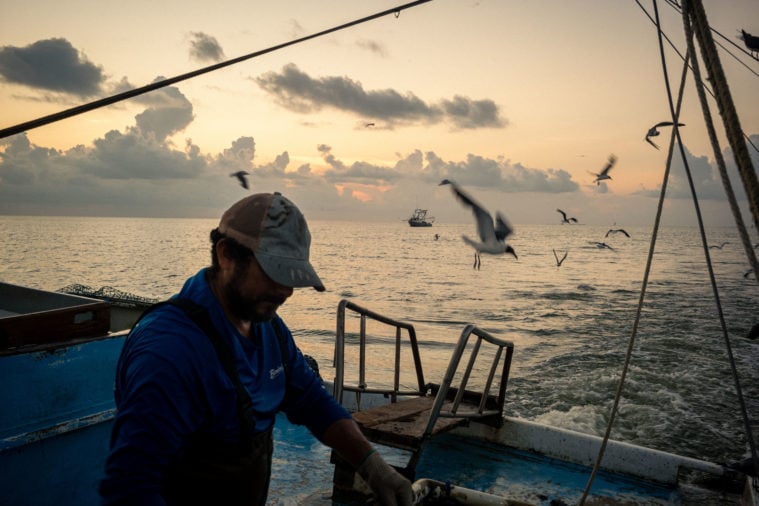
In Matagorda Bay, seagulls feed off the back of Mauricio Blanco’s boat as his brother sorts the fish they will bring to market and the fish that are too small to sell. According to environmental activists, dredging the bay will harm the fishing industry by decimating the environment that fish and shrimp feed in. Credit: Ivan Armando Flores/Texas Observer -

In Matagorda Bay, seagulls feed off the back of Mauricio Blanco’s boat as his brother sorts the fish they will bring to market and the fish that are too small to sell. According to environmental activists, dredging the bay will harm the fishing industry by decimating the environment that fish and shrimp feed in. Credit: Ivan Armando Flores/Texas Observer
Now, an energy company called Max Midstream threatens what little stability fishermen like Blanco have scraped together. The company plans to turn a portion of the bay, along the Port of Calhoun, into a new crude oil export hub that could rival Houston or Corpus Christi, which have led the nation in crude oil exports since the export ban was lifted. Using existing pipelines that feed into plastics plants in the bay, Max Midstream will pipe in 4.2 million barrels of oil a month from the Permian Basin as well as the Eagle Ford Shale in South Texas, and load it onto some of the largest tankers in the world headed for Asia and Europe.
In Matagorda Bay, Max Midstream will dredge a deeper ship channel in the bay to accommodate the large tankers, known as Very Large Crude Carriers (VLCCs), that it plans to service. The energy company will pay $360 million to deepen the ship channel, while the Port of Calhoun shoulders an additional $120 million in costs. Max Midstream and the Port of Calhoun did not respond to requests for comment, but in a company press release in 2020, the port’s director, Charles Hausmann, said, “This will transform our port into a major oil exporting center, and it will transform our area with new jobs and new growth.”
The terminal sits next to a Superfund site: an old aluminum smelter that once dumped millions of pounds of mercury into Lavaca Bay. According to an U.S. Army Corps of Engineers report, disturbing the bay with dredging could unsettle the buried toxins, undoing years of work rehabilitating the bay’s ecosystem, and destroy 130 acres of oyster reefs. The Corps promises to build new reefs, but in the years it takes for those to mature, the fishermen’s livelihood will be decimated. “But the officials here,” Blanco says, “they don’t give a damn.”
In Corpus Christi, an offshore terminal called Bluewater, sponsored by Phillips 66 and a Swiss company called Trafigura, could threaten the health of one of the largest continuous seagrass beds in Texas. The project’s pipelines will cross through Redfish Bay, a protected state scientific area. The seagrass acts as a natural carbon sink, pulling greenhouse gases out of the atmosphere as it provides crucial habitat to aquatic species; an oil spill could be detrimental to the habitat. In a statement, a Phillips 66 spokesperson said that the company is committed to developing a “design that ensures safe and environmentally sustainable operations.”
Nearby, one of the largest oil export terminals in the United States, Moda, is planning an expansion, too.
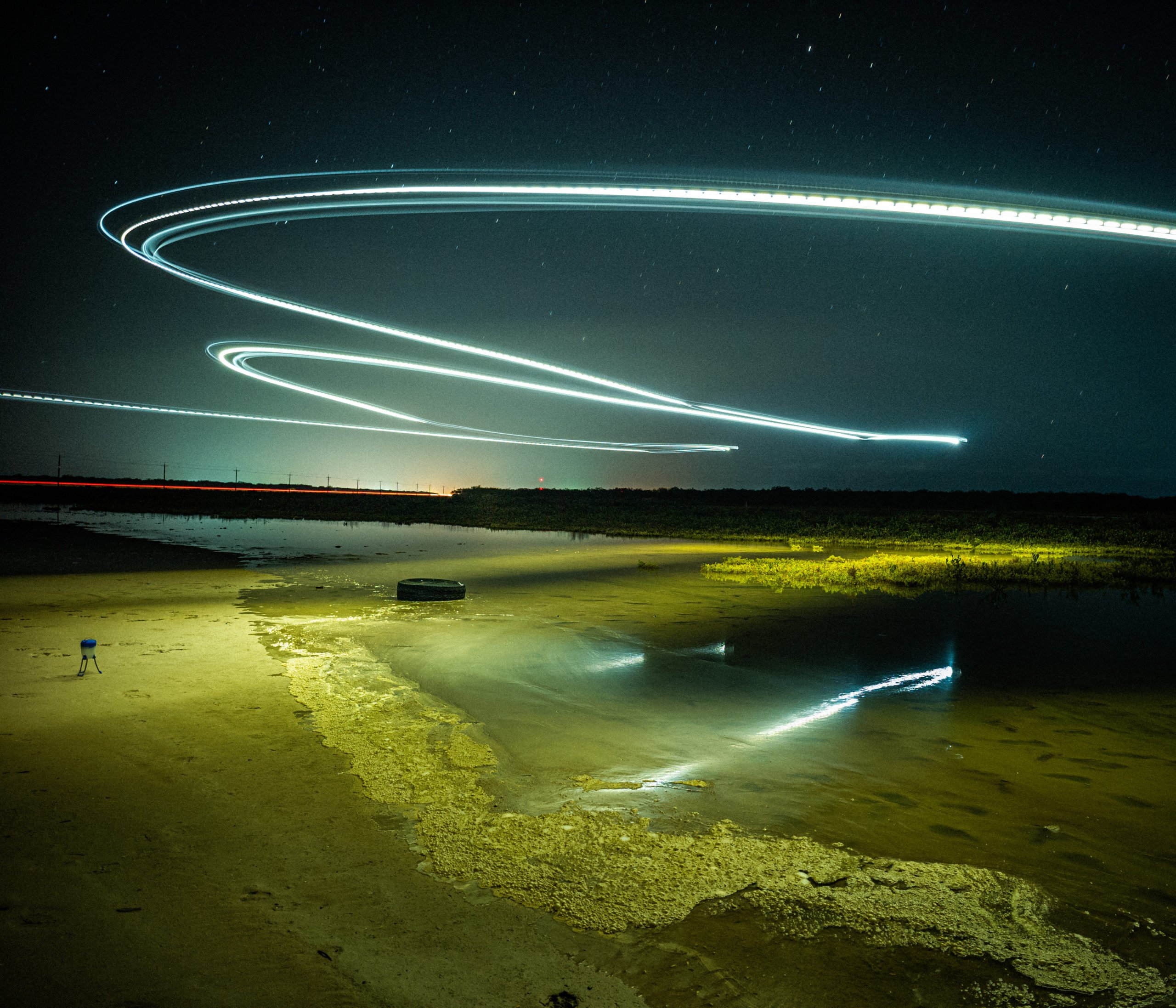
Envisioning the Effects of Big Oil and Gas Along the Texas Coast
These images imagine how forthcoming LNG facilities in Texas will take over the land.
Two groups—the Indigenous People of the Coastal Bend and the Karankawa Kadla tribe of Texas—have filed a lawsuit against the U.S. Army Corps of Engineers for approving Moda’s expansion, which will destroy 10 acres of wetlands by the bay. The groups claim that the expansion will destroy what remains of their historic connection to the land and water. The site of the proposed expansion is also known to be a historic site where artifacts such as pottery, tools, and bones have been found. A company spokesperson said in a statement that Moda is confident its application review process was comprehensive and that the permit was “properly issued.”
Love Sanchez, who identifies as Karankawa and grew up near the bay with her family, says it hurts just thinking about losing access to the land and water. So much of the area is owned privately, and only a few public spaces remain accessible to families like hers. “I know that being a realist, you gotta think about what’s to come. But that’s not where I’m at,” Sanchez says.
About 200 miles up the coast in Brazoria County, two offshore terminals have also been proposed, which will alter the landscape of the coast as well as residential communities farther inland, where some of the storage infrastructure must be built. For its Sea Port Oil Terminal, Enterprise Products and Enbridge will lay 30 miles of pipeline through an undeveloped beach on Surfside, which provides a crucial habitat to endangered turtle species. Nearby, Sentinel Midstream will build a 262-acre storage tank facility for its proposed export terminal, called GulfLink. The storage facility is just across the road from a residential neighborhood in the small town of Jones Creek. Crude oil stored at the facility can release harmful pollution, and a spill, particularly during a heavy rainstorm or hurricane like Harvey, would be catastrophic.
“The attitude seems to be, ‘Well, Freeport and Jones Creek, they have hundreds of oil and gas pipelines. What’s a few more going to be?’” says Melanie Oldham, the environmental activist in Freeport. “We feel like the sacrifice zone, because it never stops. [The companies] never thought anyone would question them for choosing a tank farm site in a residential area.”
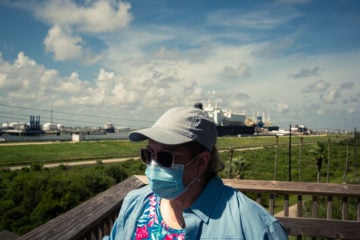
In a statement, Enterprise said that the American oil it would export will be “better for the global environment” than foreign oil. GulfLink’s CEO, Jeff Ballard, wrote that the company’s terminal would “lessen the impact of harmful air pollutants on low-income communities near the Houston Ship Channel” and that there would not be a “disproportionately high and adverse impact” on environmental justice communities in Brazoria County.
Both the proposed Enterprise and Sentinel facilities would pump thousands of tons of pollution into the air. Brazoria county has long had severe air pollution, frequently in violation of federal standards, but because the projects will be offshore, their emissions don’t have to be scrutinized for how they would affect the county’s air.
Cindy Jordy, a retired environmental scientist who worked at the Phillips 66 refinery nearby, says the Gulf Coast’s circular wind patterns will almost certainly bring volatile organic compounds, carbon dioxide, and other emissions back to land. Jordy spent decades writing pollution permits for the plant, which had to abide by federal standards requiring ozone reduction methods. “The permit applications were cleverly crafted,” Jordy says, stopping short of calling this a loophole. “I don’t think they have adequately looked at the emissions impact to the area.”
This spring, Texas activists traveled to Washington, D.C., to protest the Biden administration’s tacit support of the LNG and oil export permits, many of which, they say, were rushed through under former President Donald Trump. More than 200 organizations and communities stretching from the Texas Gulf Coast to Florida signed onto a letter advocating that President Biden reinstate the crude oil export ban and expand it to include natural gas exports. Study after study has concluded that in order to stave off the worst impacts—hurricanes stronger than Harvey or Ida, never-ending wildfires and droughts, deadly heat waves—most of the oil and gas currently in the ground needs to stay there.
“We cannot lead the world in being environmentally friendly if we export the problems we’re creating to others,” said Beard, the Port Arthur activist, from the steps of the Department of Energy.
While the activists spoke in front of the agency, Diane Wilson—perhaps Matagorda Bay’s most well-known environmentalist—launched a hunger strike demanding that President Biden put an end to the Port of Calhoun dredging project. “This is like a nail in the coffin for fishermen’s livelihoods,” she says.

For years, Wilson waged war against the plastics manufacturing giant Formosa, which was dumping millions of plastic pellets in waterways that the retired shrimper, now 72, used to rely on for a living.
In 2019, she won a $50 million settlement against the company, one of the largest private settlements in U.S. history. Some of the money is going toward environmental cleanups; a chunk of it will also help start a fishermen’s co-op to rebuild some of the fish houses and docks that have disappeared over the years. Not long after she won the lawsuit against Formosa, Wilson got sucked into fighting Max Midstream’s plans.
After the hunger strike failed to get the federal government’s attention, Wilson drove up to the Army Corps’ office in Galveston with a fake coffin in tow. On the side, she had painted in tall white letters “Dredging = Death to Matagorda Bay.” After being arrested for civil disobedience at the government building, she says she still has the coffin, which she plans to take out to the bay near Max Midstream for another protest sometime soon. “I like Biden. I think he’s a 100 percent improvement,” Wilson says. “But I’m not sitting here waiting on him to solve this for me.”
On a blistering hot Friday in August, the last weekend before school starts, families set up umbrellas and beach chairs as they catch fish off the shore of South Padre Island. Every once in a while, a dolphin pops its head out of the water. A third-generation resident of Brownsville, Emma Guevara and her family would make beach trips like this when she was growing up, almost every weekend over the summer.
“It’s a tradition for a lot of families here in Brownsville. I have photos of my grandma as a little kid on the beach, and then photos of my mom as a little kid on the beach, and myself and my younger siblings.” Her family would fish here, too, and eat what they’d caught in the afternoons.
When Guevara looks out onto the water now, toward the flat expanse of the horizon, she sees what might become of the quiet bay and its beauty: Two energy companies have leased land near Port Isabel, and they plan to build liquified natural gas plants the size of several city blocks to process and compress millions of tons of gas from the Permian Basin. The plants’ towering flare stack will release harmful air pollutants. Tankers will line up in front of the plant, blocking the view from the beach to the Gulf of Mexico. The plants’ security protocols will likely require that the waterways nearby remain closed to local residents when the ships are loading.
“In 30 years, I think those memories are gone,” she says, motioning toward the nearby families on the beach. “It breaks my heart now to think about the future. If I ever have kids, will I be able to take them here?” About a year ago, Guevara joined the Sierra Club as an organizer in the Rio Grande Valley. Environmentalists, grassroots groups, and city officials alike have united against the plants, which they say will destroy the local ecology and harm communities. The LNG plants will be located off the Bahia Grande, one of the country’s largest wetland-restoration projects and a habitat for several rare species of birds. Rio Grande LNG did not respond to a request for comment, and Texas LNG’s spokesperson said that the company “hasn’t seen any credible evidence of environmental threats.”
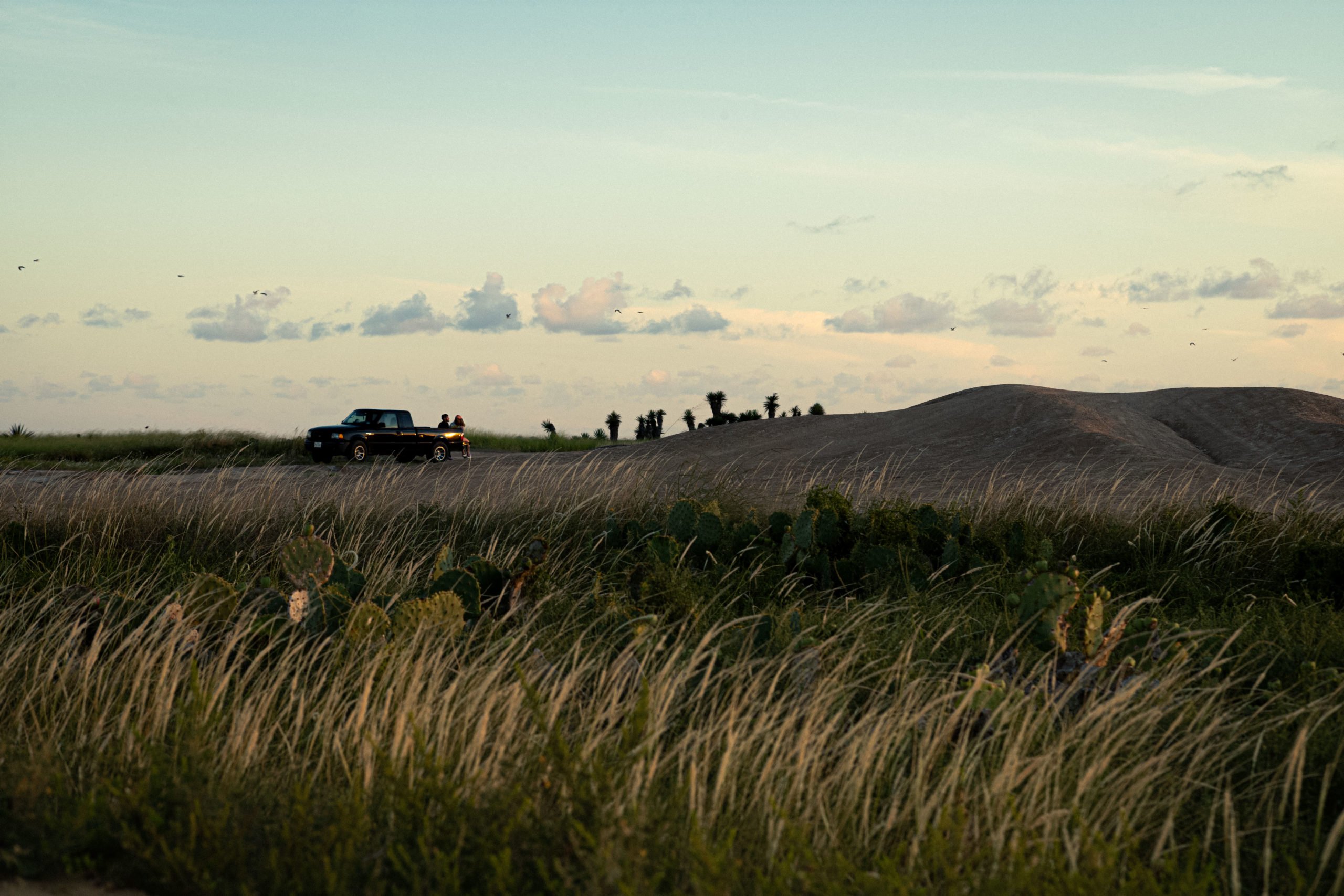
Texas LNG’s proposed plant will also disrupt an archaeological site containing Indigenous artifacts and a burial ground. For Christopher Basaldu, an organizer with the Sierra Club, the company’s decision to continue building on the site and exporting gas to Europe is proof of an ongoing legacy of colonialism. “This industry acts as if Native people do not exist,” he says. “[The companies] have no relationship to the land or the water. They just want to make more money. And they’ll do it at the cost of destroying the ecosystem and destroying the health of families.”
The Port of Brownsville has long been one of the state’s major deep-water ports, but it’s never been a major energy corridor, like the Houston Ship Channel, Corpus Christi, or Freeport. With the new LNG developments, the port is laying the groundwork to become a key part of the state’s energy economy, regardless of how local residents feel about it.
“We’re the last unindustrialized port on the Texas coast,” says Kyle Burnell, a local shrimper who runs a shrimp house that will likely be displaced by the LNG plants. “And here they are like, ‘Well, hey, that place looks beautiful. Let’s put a fucking processing plant there.’”
But years of activism in Brownsville have begun to pay off. In early August, the Sierra Club, along with grassroots groups and the city of Port Isabel, won a lawsuit that they’d filed against the Federal Energy Regulatory Commission (FERC), alleging its environmental impact analyses for the two LNG plants had failed to account for the public health, environmental justice, and climate impacts of the projects on the community. A federal court ruled in their favor, and now the agency will have to redo its studies. Though the projects’ permits have not been canceled, it presents a significant setback for the two companies, says Rebekah Hinojosa, a Sierra Club organizer. “FERC has pretty much rubber-stamped every permit for every LNG terminal,” she says. “Right now is the opportunity for the commission to do its job, and that’s what we’re hopeful for.” In the meantime, Hinojosa says, activists in the area plan to continue pressuring other players, too: banks that finance the plants and countries that sign import deals with the terminals. These strategies, she says, played a part in tanking a third LNG plant: In April, Annova LNG abruptly canceled its project after failing to secure long-term export contracts.
In Brownsville, where industry doesn’t have a stranglehold on the community’s ecology or economy yet, Hinojosa worries that the LNG plants, if they go through, would be a catalyst. “The way that industry works, first they build a plant,” she says. “But that’s not all. Then they add more pipelines, and they expand the facility, and it just keeps growing.”
The sunset over the city is warm and golden. But years from now, when the waning rays shine through heavy pollution, the sky might deepen to spectacular shades of pink and orange, just like the sunsets nearly 400 miles north in Port Arthur: a beautiful backdrop for the towering metal structures that loom over the coast.
This story was supported by the Institute for Journalism and Natural Resources and the Pulitzer Center’s Connected Coastlines Initiative and published in partnership with The Nation.
